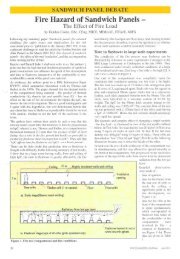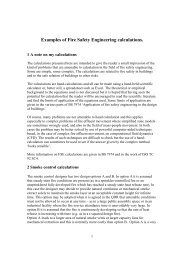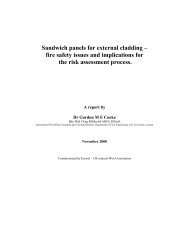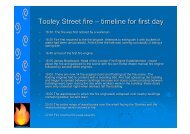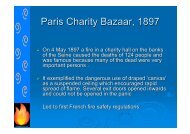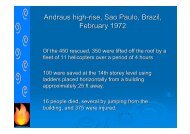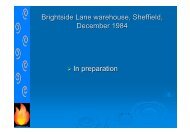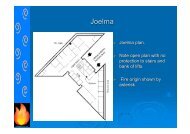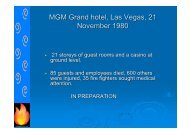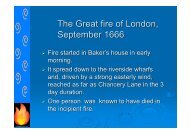Summerland leisure centre, Isle of Man, August 1973
Summerland leisure centre, Isle of Man, August 1973
Summerland leisure centre, Isle of Man, August 1973
Create successful ePaper yourself
Turn your PDF publications into a flip-book with our unique Google optimized e-Paper software.
<strong>Summerland</strong> <strong>leisure</strong> <strong>centre</strong>, <strong>Isle</strong> <strong>of</strong> <strong>Man</strong>,<strong>August</strong> <strong>1973</strong>‣ At 20.00 on 2nd <strong>August</strong> <strong>1973</strong> fire started outside this <strong>leisure</strong><strong>centre</strong> building and spread into the interior, especially theamusements area.‣ Of the estimated 3000 people present at the time, some 50men, women and children died.‣ This was the worst peacetime fire disaster in the British <strong>Isle</strong>ssince 1929.
‣ <strong>Summerland</strong> fire in progress. Note steep rising land on one sidemaking access difficult for the fire brigade
<strong>Summerland</strong> – building data‣ <strong>Summerland</strong> was part <strong>of</strong> a 7-storey 7covered <strong>leisure</strong> complex inDouglas, <strong>Isle</strong> <strong>of</strong> <strong>Man</strong>, having a lot <strong>of</strong> open space and severalupper floors arranged as open-fronted terraces. Opened in1971 it had a capacity <strong>of</strong> 5000 people.‣ It was steel framed and the ro<strong>of</strong> and parts <strong>of</strong> the external wallwere clad in transparent Oroglas polymethylmethacrylate(PMMA) acrylic plastic sheeting. Some parts <strong>of</strong> the ro<strong>of</strong>consisted <strong>of</strong> woodwool slabs with felt and chippings on top.‣ Parts <strong>of</strong> the external wall were clad with Galbestos (steel sheethaving a combustible coating on both faces) and a Decalincombustible fibreboard internal lining on timber studs, theDecalin was unfortunately substituted for plasterboard.
<strong>Summerland</strong> – building data‣ The building had a two-stage manual fire alarm systemwhich required the use <strong>of</strong> call points.‣ There were 14 hose reels installed in the building There wasa diesel engine emergency power generator.‣ There were three access points for fire appliances to getwithin 60 ft <strong>of</strong> the building.‣ A main stair poorly placed in the north-east corner <strong>of</strong> thebuilding, which also served as a service stair and was notprotected by fire lobbies, contained a 3”wet 3falling main withan outlet at each occupied level.‣ There were six street hydrants within 150 ft <strong>of</strong> the buildingbut water pressure was poor
<strong>Summerland</strong> – the fire‣ Fire started in the remains <strong>of</strong> a fibreglass kiosk left outside but bnext to the Galbestos steel sheeted portion <strong>of</strong> the external wall<strong>of</strong> the complex.‣ The plastic coating on the Galbestos ignited and fire wastransmitted into and up the void in the external wall formedbetween the Decalin and the Galbestos (the latter has a zinccoated steel sheet core covered with asbestos felt saturatedwith bitumen, faced with a polyester resin coating).‣ Fire spread into the amusement arcade and conflagrationoccurred in the whole <strong>of</strong> the east end <strong>of</strong> the building, and thefire then spread westwards.‣ It appeared that the fire alarm signal was not passed to the firebrigade until roughly 20 minutes after discovery <strong>of</strong> the fire.
<strong>Summerland</strong> – the fire‣ Even then it did not simultaneously result in raising an alarm in thecomplex, though the fire alarm system was said to be elaborate‣ In fact the fire was notified to the fire brigade by a ship at sea sbeforethe alarm was received from the complex.‣ Another unaccountable feature was that the emergency lighting failedafter the main electrical supply had mistakenly been turned <strong>of</strong>f by theHouse <strong>Man</strong>ager and the emergency power generator failed to start.‣ Fire spread rapidly because the voids had combustible surfaces,there was no fire stopping in the external cavities and there werepoor arrangements for evacuation <strong>of</strong> people and fire fighting.‣ It was claimed that the detailed means <strong>of</strong> escape could not beconsidered at the early design stage because the tenant was not yetnominated, but this reason was not accepted by the investigatingCommission
<strong>Summerland</strong> – observationsSeveral strategic elements were unsatisfactory:‣ Uncertain responsibilities <strong>of</strong> principal and job architects whohad little experience <strong>of</strong> projects <strong>of</strong> this size and kind‣ Poor communication between fire <strong>of</strong>ficer and designers‣ The inaccessible position <strong>of</strong> the main entrance on its highterrace as reached from the road‣ The lack <strong>of</strong> good and quick access for fire fighting‣ Absence <strong>of</strong> any compartmentation in the volume above theentrance floor‣ Lack <strong>of</strong> adequate number and width <strong>of</strong> protected escapestairs‣ The use <strong>of</strong> greater expanses <strong>of</strong> acrylic on walls and ro<strong>of</strong>than was needed for transparency‣ The presence <strong>of</strong> vertical voids in the external wall withcombustible surfaces, (very hazardous as fire can travelunseen and is difficult to extinguish).
<strong>Summerland</strong> – observationsSeveral strategic elements were unsatisfactory:‣ Use <strong>of</strong> combustible s<strong>of</strong>twood structural floors for the upperterraces‣ Haphazard arrangement and use <strong>of</strong> stairs and exits‣ Some fire doors not self closing and not exit signed‣ No evacuation procedure and fire emergency trainingestablished‣ Lack <strong>of</strong> simple scientific knowledge (about materials andabout standard performance requirements for buildings)demonstrated by the designers eg BRE was not consulted onthe use <strong>of</strong> Oroglas or Galbestos‣ BS 476 fire tests were potentially misleading as the small-scale tests did not indicate fire behaviour in full scaleconditions (though the Commission accepted that small scaletests were compromises)
<strong>Summerland</strong> – Commission findingsThe design team appeared not to appreciate that:‣ there could be high densities <strong>of</strong> people congregated in particularareas‣ the building would be unfamiliar to casual (once only) visitors‣ the combination <strong>of</strong> the above could lead to panic‣ there could be relatively immobile people, very young and very old opeople and the disabled‣ children might be unaccompanied and in different parts <strong>of</strong> thebuilding away from their guardians‣ there would be a lot <strong>of</strong> combustible material present and thepotential for outbreaks <strong>of</strong> fire‣ vandalism was possible
<strong>Summerland</strong> – Commission findings‣ The lessees displayed little understanding <strong>of</strong> the fire risk -they had decided against installing sprinklers even thoughthe insurer had <strong>of</strong>fered a substantial premium reduction.‣ The Commission made 34 recommendations. <strong>Man</strong>y havebeen addressed in subsequent national regulations and<strong>of</strong>ficial guidance.‣ Some <strong>of</strong> the recommendations are especially relevant topresent fire engineered buildings which depend critically ongood fire safety management.



